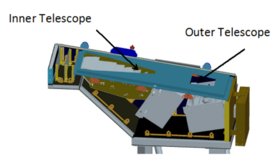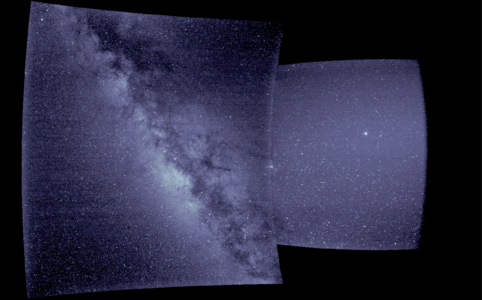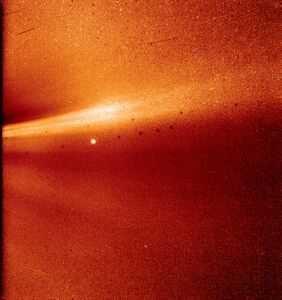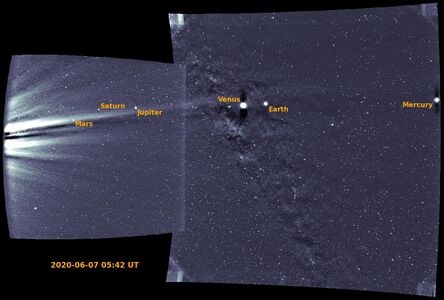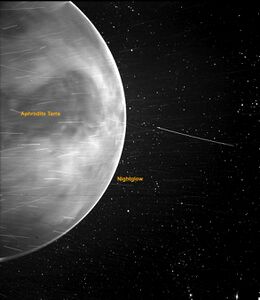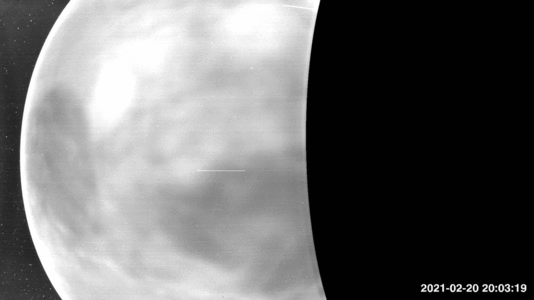Astronomy:WISPR
The Wide-Field Imager for Solar Probe (WISPR) is an imaging instrument of the Parker Solar Probe mission to the Sun, launched in August 2018.[1] Imaging targets include visible light images of the corona, solar wind, shocks, solar ejecta, etc.[1] Development of WISPR was led by the U.S. Naval Research Laboratory.[2] The Parker Solar Probe with WISPR on board was launched by a Delta IV Heavy on 12 August 2018 from Cape Canaveral, Florida.[3] WISPR is intended take advantage of the spacecraft's proximity to the Sun by taking coronagraph-style images of the solar corona and features like coronal streamers, plumes, and mass ejections.[4] One of the goals is to better understand the structure of the solar corona near the Sun.[4]
WISPR is designed to study the electron density and velocity structure of the corona.[5] The instrument field of view is planned to extend from 13 to 108 degrees away from the Sun, and does not directly image the Sun; the area of interest is a very wide field extending away from the Sun.[1]
WISPR includes two separate telescopes, each with a radiation-hardened CMOS imager with resolution of 2,048×1,920 pixels.[6] The CMOS sensors are an active pixel sensor type of detector.[7]
The WISPR first light image was published in September 2018.[8] In December, a view of the corona including a coronal streamer was released.[9]
In November 2018, a video of WIPSR recording solar wind during the spacecraft's first close pass to the Sun was released.[10] One project scientist noted, "The data we’re seeing from Parker Solar Probe’s instruments is showing us details about solar structures and processes that we have never seen before."[10]
Development
The stray light and baffle for WISPR was modeled during development of the instrument.[11] Two noted cases where stray material caused issue with space imaging includes the Infrared Telescope (IRT) flown on the Space Shuttle Spacelab-2 mission, in which a piece of mylar insulation broke loose and floated into the line-of-sight of the telescope corrupting data.[12] This was on the STS-51-F in the year 1985.[12] Another case was in the 2010s on the Gaia spacecraft for which some stray light was identified coming from fibers of the sunshield, protruding beyond the edges of the shield.[13]
Gallery
WISPR first light image. The right portion of the image is from WISPR's inner telescope, which is a 40-degree field of view and begins 58.5 degrees from the Sun's center. The left portion is from the outer telescope, which is a 58-degree field of view and ends about 160 degrees from the Sun.[8]
The view from the probe's WISPR instrument on Sept. 25, 2018, shows Earth, the bright sphere near the middle of the right-hand panel. The elongated mark toward the bottom of the panel is a lens reflection from the WISPR instrument[14]
Photo from the WISPR shows a coronal streamer, seen over the east limb of the Sun on Nov. 8, 2018, at 1:12 a.m. EST. The fine structure of the streamer is very clear, with at least two rays visible. Parker Solar Probe was about 16.9 million miles from the Sun's surface when this image was taken. The bright object near the center of the image is Mercury, and the dark spots are a result of background correction.[9]
When Parker Solar Probe was making its closest approach to the Sun on June 7, 2020, WISPR captured the planets Mercury, Venus, Earth, Mars, Jupiter and Saturn in its field of view[15]
Photo taken by the probe during its second Venus flyby, July 2020
As Parker Solar Probe flew by Venus on its fourth flyby, its WISPR instrument captured these images, showing the nightside surface of the planet[16]
As the probe passed through the Sun's corona in early 2021, it flew by structures called coronal streamers
See also
References
- ↑ 1.0 1.1 1.2 "Looking at the Corona with WISPR on Parker Solar Probe". NASA/Goddard Media Studios. 16 April 2018. https://svs.gsfc.nasa.gov/12927.
- ↑ "NRL's Sun Imaging Telescopes Fly on NASA Parker Solar Probe". U.S. Navy. 10 August 2018. https://www.navy.mil/submit/display.asp?story_id=106691.
- ↑ Brown, Geoffrey; Brown, Dwayne; Fox, Karen (12 August 2018). "Parker Solar Probe Launches on Historic Journey to Touch the Sun". Johns Hopkins University Applied Physics Laboratory. http://parkersolarprobe.jhuapl.edu/News-Center/Show-Article.php?articleID=94.
- ↑ 4.0 4.1 "NRL's Sun Imaging Telescopes Fly on NASA Parker Solar Probe". U.S. Navy/Naval Research Laboratory. 10 August 2018. https://www.navy.mil/submit/display.asp?story_id=106691. Retrieved 7 October 2018.
- ↑ "Wide-Field Imager for Solar Probe Plus (WISPR)". U.S. Navy/Naval Research Laboratory. https://www.nrl.navy.mil/ssd/branches/7680/WISPR.
- ↑ "Wide-Field Imager for Solar Probe (WISPR)". SRI International. https://www.sri.com/work/projects/wide-field-imager-solar-probe-wispr.
- ↑ Garner, Rob, ed (12 July 2018). "Parker Solar Probe Instruments". NASA. https://www.nasa.gov/content/goddard/parker-solar-probe-instruments.
- ↑ 8.0 8.1 Frazier, Sarah; Surowiec, Justyna (19 September 2018). "Illuminating First Light Data from Parker Solar Probe". Johns Hopkins University Applied Physics Laboratory. http://parkersolarprobe.jhuapl.edu/News-Center/Show-Article.php?articleID=101.
- ↑ 9.0 9.1 "Preparing for Discovery With NASA's Parker Solar Probe" (in en). Johns Hopkins University Applied Physics Laboratory. http://parkersolarprobe.jhuapl.edu/News-Center/Show-Article.php?articleID=115.
- ↑ 10.0 10.1 Garner, Rob (2019-08-12). "One Year, 2 Trips Around Sun for NASA's Parker Solar Probe". http://www.nasa.gov/feature/goddard/2019/one-year-2-trips-around-sun-for-nasas-parker-solar-probe.
- ↑ Hellin, M.-L.; Mazy, E.; Marcotte, S.; Stockman, Y.; Korendyke, C.; Thernisien, A. (25 September 2017). "Stray light testing of WISPR baffle development model". International Conference on Space Optics — ICSO 2016. 10562. SPIE. pp. 1420–1428. doi:10.1117/12.2296104. ISBN 9781510616134. Bibcode: 2017SPIE10562E..4VH.
- ↑ 12.0 12.1 Kent, S. M.; Mink, D.; Fazio, G.; Koch, D.; Melnick, G.; Tardiff, A.; Maxson, C. (1 February 1992). "Galactic Structure from the Spacelab Infrared Telescope. I. 2.4 Micron Map". The Astrophysical Journal Supplement Series 78: 403. doi:10.1086/191633. Bibcode: 1992ApJS...78..403K. http://adsabs.harvard.edu/full/1992ApJS...78..403K. Retrieved 29 April 2022.
- ↑ "20141217 Status of Gaia straylight analysis - Gaia - Cosmos". http://www.cosmos.esa.int/web/gaia/news_20141217.
- ↑ Garner, Rob (22 October 2018). "Parker Solar Probe Looks Back at Home". https://www.nasa.gov/feature/goddard/2018/parker-solar-probe-looks-back-at-home.
- ↑ Buckley, Mike. "Parker Solar Probe Captures a Planetary Portrait" (in en). Johns Hopkins APL. http://parkersolarprobe.jhuapl.edu/News-Center/Show-Article.php?articleID=158.
- ↑ Hatfield, Miles (9 February 2022). "Parker Solar Probe Captures Visible Light Images of Venus' Surface". https://www.nasa.gov/feature/goddard/2022/sun/parker-solar-probe-captures-its-first-images-of-venus-surface-in-visible-light-confirmed.
External links
- Looking at the Corona with WISPR on Parker Solar Probe (April 16, 2018)
 |
